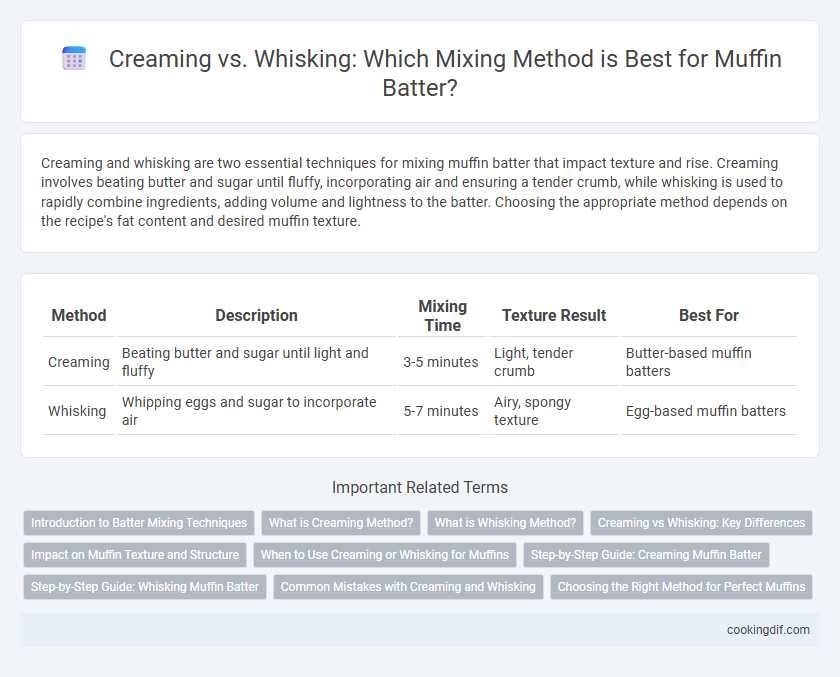Creaming and whisking are two essential techniques for mixing muffin batter that impact texture and rise. Creaming involves beating butter and sugar until fluffy, incorporating air and ensuring a tender crumb, while whisking is used to rapidly combine ingredients, adding volume and lightness to the batter. Choosing the appropriate method depends on the recipe's fat content and desired muffin texture.
Table of Comparison
| Method | Description | Mixing Time | Texture Result | Best For |
|---|---|---|---|---|
| Creaming | Beating butter and sugar until light and fluffy | 3-5 minutes | Light, tender crumb | Butter-based muffin batters |
| Whisking | Whipping eggs and sugar to incorporate air | 5-7 minutes | Airy, spongy texture | Egg-based muffin batters |
Introduction to Batter Mixing Techniques
Creaming and whisking are two essential batter mixing techniques that impact the texture and rise of muffins. Creaming involves beating butter and sugar together to incorporate air, producing a light, tender crumb, while whisking uses rapid motion to blend liquid ingredients and incorporate air for a fluffy batter. Understanding these methods helps achieve the desired muffin consistency, whether moist and dense or airy and soft.
What is Creaming Method?
The creaming method involves beating butter and sugar together until light and fluffy, incorporating air that helps create a tender and airy muffin texture. This technique is essential for batters that require a soft crumb and even rise, as the creamed mixture traps tiny air bubbles that expand during baking. Properly creamed butter and sugar ensure moistness and a delicate crumb in muffin recipes.
What is Whisking Method?
Whisking method involves beating eggs and sugar vigorously to incorporate air, creating a light and fluffy mixture essential for certain muffin batters. This technique produces a foam that helps leaven the batter without relying heavily on chemical leaveners. Whisking is ideal for delicate muffins where a tender crumb and airy texture are desired.
Creaming vs Whisking: Key Differences
Creaming involves beating butter and sugar together to create a light, airy texture that helps trap air for leavening in muffin batter, resulting in a tender crumb. Whisking, on the other hand, incorporates air by vigorously mixing eggs and sugar, producing a foam that provides structure and lightness primarily in sponge-based batters. Choosing creaming over whisking in muffin recipes typically yields denser, moister muffins, while whisking leads to lighter, more delicate textures.
Impact on Muffin Texture and Structure
Creaming incorporates air by beating butter and sugar until fluffy, resulting in a lighter, tender muffin crumb with even rise. Whisking blends wet ingredients to trap air, producing a more uniform, slightly denser texture but still maintains moisture. Choosing creaming enhances softness and volume, while whisking promotes a finer crumb and consistent structure in muffins.
When to Use Creaming or Whisking for Muffins
Creaming is ideal for muffin batters that require a light, tender crumb, achieved by beating butter and sugar to incorporate air before adding other ingredients. Whisking works best for muffin recipes emphasizing speed and minimal fat, using vigorous mixing to aerate eggs and sugar, resulting in a fluffier texture. Choose creaming for richer, buttery muffins and whisking for lighter, sponge-like muffins to optimize texture and rise.
Step-by-Step Guide: Creaming Muffin Batter
Creaming muffin batter involves beating butter and sugar together until light and fluffy, incorporating air to create a tender crumb. Begin by softening the butter to room temperature, then use an electric mixer to blend it with sugar for 3-5 minutes until pale and creamy. Gradually add eggs and dry ingredients, mixing gently to maintain the airy texture essential for moist, tender muffins.
Step-by-Step Guide: Whisking Muffin Batter
Whisking muffin batter begins by combining wet ingredients thoroughly to incorporate air, creating a light and fluffy texture. Gradually fold in dry ingredients using a gentle motion to avoid overmixing, which can cause dense muffins. Proper whisking ensures even distribution of ingredients, resulting in consistent rise and tender crumb structure.
Common Mistakes with Creaming and Whisking
Overmixing is a common mistake with creaming, causing dense, tough muffins due to excessive gluten development. In whisking, undermixing leads to uneven batter and poor rise, while overwhisking can incorporate too much air, resulting in coarse texture and large air pockets. Both methods require precise timing to balance aeration and gluten formation for optimal muffin crumb.
Choosing the Right Method for Perfect Muffins
Choosing the right mixing method is crucial for perfect muffins, as creaming and whisking yield distinct textures. Creaming involves beating butter and sugar until light and fluffy, creating a tender crumb by incorporating air, ideal for rich, dense muffins. Whisking combines eggs and sugar vigorously to trap air, resulting in lighter, more delicate muffins with a finer crumb structure.
Creaming vs Whisking for batter mixing Infographic

 cookingdif.com
cookingdif.com